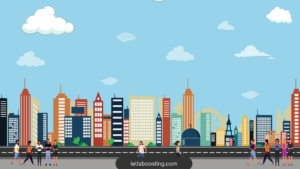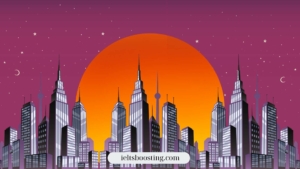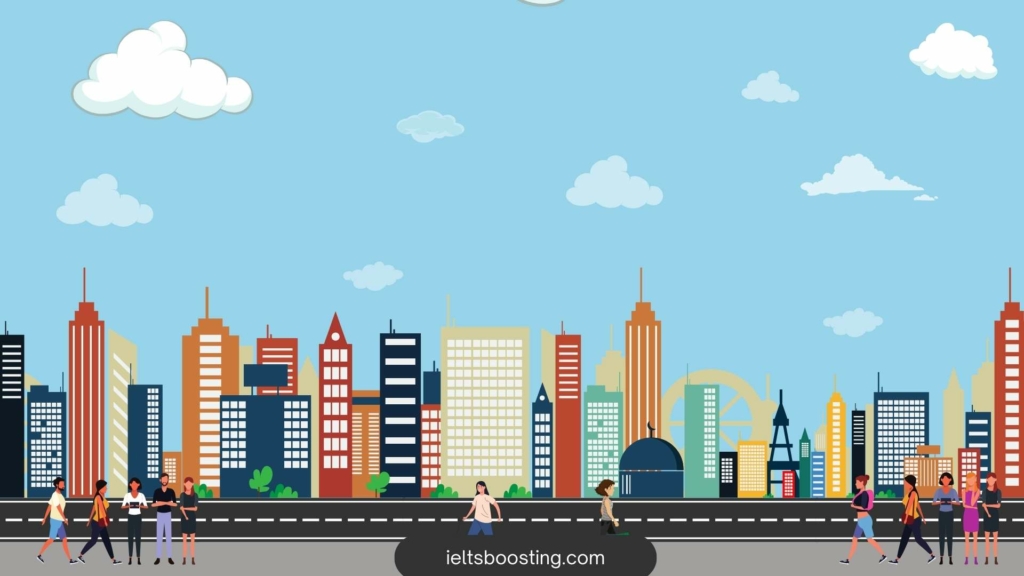Describe a beautiful city
You should say:
Where the city is
How you knew about the city
What buildings the city has
What it is famous for
And explain why you think this city is beautiful

Describe a beautiful city
Sample answer for describe a beautiful city
One of the most beautiful cities I’ve had the privilege to visit is Hanoi, the capital of Vietnam. I first learned about this captivating city through books and documentaries that showcased its rich history, cultural heritage, and stunning architecture. Hanoi is a city that seamlessly blends the old and the new. It boasts an impressive array of historical and architectural gems, including the iconic Hanoi Opera House, a magnificent French colonial-era structure, and the Temple of Literature, a centuries-old Confucian temple that serves as a testament to Vietnam’s scholarly traditions. The city is also home to the exquisite Hoan Kiem Lake, surrounded by lush greenery and the historic Ngoc Son Temple,
creating an idyllic urban oasis. What makes Hanoi truly famous, however, is its vibrant street culture and culinary scene. The city is renowned for its bustling street markets, where you can savor the best of Vietnamese street food, from savory photo delectable banh mi sandwiches. The Old Quarter of Hanoi, with its narrow winding streets and traditional shop houses, provides an authentic glimpse into the
city’s past and is a treasure trove for history enthusiasts. Hanoi’s beauty lies in its ability to preserve its rich cultural heritage while embracing modernity. The city’s centuries-old pagodas stand in harmony with contemporary skyscrapers, creating a unique visual tapestry that encapsulates Vietnam’s complex history. Moreover, the warm and welcoming spirit of the Hanoian people adds to the city’s charm, making it a place where beauty is not only in the architecture but also in the heartwarming hospitality.
In conclusion, Hanoi is a city that exudes beauty from every corner, whether it’s the majestic architecture, the aromatic street food, or the genuine warmth of its residents. Its ability to embrace the past and the present, coupled with its rich cultural tapestry, makes Hanoi an
exceptionally beautiful city that leaves a lasting impression on all who visit.
High-level vocabulary for describe a beautiful city
● Captivating – Quyến rũ
● Rich history – Lịch sử phong phú
● Architectural gems – Các kiệt tác kiến trúc
● Magnificent – Tráng lệ
● Scholarly traditions – Truyền thống học thuật
● Exquisite – Tinh xảo
● Idyllic – Thơ mộng
● Street culture – Văn hóa đường phố
● Culinary scene – Cảnh ẩm thực
● Treasure trove – Kho báu
● Visual tapestry – Bức tranh thị giác
● Harmony – Sự hài hòa
● Hospitality – Sự mến khách
Phrasal Verbs:
● Blend the old and the new – Kết hợp cổ điển và hiện đại
● Savor the best – Thưởng thức những điều tốt nhất
● Stand in harmony – Tồn tại trong sự hài hòa
● Exudes beauty – Tỏa sáng vẻ đẹp
● Leave a lasting impression – Để lại ấn tượng sâu sắc

Describe a beautiful city
Part 3-describe a beautiful city ielts speaking
What are the differences between modern towns and modern cities?
Modern cities, like Tokyo, typically offer a vast array of services and amenities, such as extensive public transportation and diverse job markets, whereas towns may have fewer services and local employment opportunities. Cities often feature a fast-paced lifestyle with a high cost of living, while towns like Bath in England tend to offer a slower pace and a more close-knit community atmosphere. Urban areas are marked by high population density and towering skyscrapers, in contrast to the low-rise buildings and spacious landscapes of towns. Lastly, cities are hubs for cultural diversity and entertainment, offering numerous museums and theaters, unlike towns, which might have more limited cultural experiences.
- Array (n) – sắp xếp: An impressive display or range of a particular type of thing.
- Amenities (n) – tiện nghi: Features that provide comfort, convenience, or enjoyment.
- Extensive (adj) – rộng lớn: Large in size, amount, or scope.
- Diverse (adj) – đa dạng: Showing a lot of variety; very different from each other.
- Fast-paced (adj) – nhanh: Moving or happening quickly; energetic and forceful.
- Close-knit (adj) – khăng khít: Tightly bound together, especially by social or cultural ties.
- Urban (adj) – thành thị: Relating to, or characteristic of a city or town.
- Hubs (n) – trung tâm: The central or main part of something where there is most activity.
Why do some people like to visit historical sites?
Some individuals visit historical sites to gain a deeper understanding of history, as these places provide a tangible connection to the events and figures of the past. Others find inspiration in the architecture and stories of bygone eras, appreciating the craftsmanship and cultural heritage. There are also those who seek a personal connection, perhaps tracing their own ancestry or experiencing a sense of belonging to a larger narrative. Lastly, historical sites often offer unique photographic opportunities for visitors, capturing the essence of a place that has withstood the test of time.
- Deeper Understanding – hiểu biết sâu sắc: A more profound or comprehensive grasp of knowledge about a subject.
- Tangible Connection – mối liên kết hữu hình: A real or concrete link or relationship that people can see, touch, or experience directly.
- Bygone Eras – các kỷ nguyên đã qua: Periods of time that have ended or passed.
- Craftsmanship – tay nghề: The quality of design and work shown in something made by hand; artistry.
- Cultural Heritage – di sản văn hóa: The legacy of physical artifacts and intangible attributes of a group or society that are inherited from past generations.
- Personal Connection – mối liên hệ cá nhân: A private or intimate association or bond with something or someone.
- Ancestry – dòng họ: One’s family or ethnic descent.
- Narrative – câu chuyện: A spoken or written account of connected events; a story.
- Photographic Opportunities – cơ hội chụp ảnh: Chances or moments that are suitable or ideal for taking photographs.
- Essence – bản chất: The intrinsic or indispensable quality or qualities that serve to characterize or identify something.
- Withstood the test of time – chịu đựng thử thách của thời gian: Endured or survived over a long period, often implying reliability or timelessness.
How can people preserve historic cities and historic buildings?
- Conservation laws – luật bảo tồn: Regulations established to protect historical sites and buildings from changes that could damage their integrity.
- Demolition – sự phá hủy: The act of destroying a building or structure, especially intentionally.
- Restoration projects – dự án phục hồi: Initiatives to repair and return old buildings and sites to their former condition.
- Traditional techniques – kỹ thuật truyền thống: Methods that have been used for a long time in the past, often handed down through generations.
- Public awareness campaigns – chiến dịch nâng cao nhận thức công chúng: Organized efforts to educate the general population about certain issues or causes.
- Local heritage – di sản địa phương: The history, culture, and built environment that is unique to a specific area.
- Financial incentives – khuyến khích tài chính: Monetary benefits provided to encourage specific actions or behaviors, in this case, the preservation of historic buildings.
Is it the government’s responsibility to preserve historic cities and historic buildings?
Many believe it is the government’s responsibility to preserve historic cities and buildings, as they are guardians of national heritage and have the means to enforce protective legislation. Governments can also provide funding and expertise for restoration projects that might be beyond the reach of private entities. However, some argue that local communities and private organizations should also participate, bringing specialized knowledge and a personal investment to conservation efforts. Ultimately, a collaborative approach that includes government, private, and community stakeholders is often seen as the most effective way to safeguard historic sites.
- Preserve (verb) – bảo tồn: To maintain something in its original or existing state.
- Guardians (noun) – người bảo vệ: Those who protect or look after something.
- Heritage (noun) – di sản: Valued objects and qualities such as historic buildings and cultural traditions that have been passed down from previous generations.
- Enforce (verb) – thi hành: To compel observance of or compliance with (a law, rule, or obligation).
- Legislation (noun) – pháp luật: Laws, considered collectively.
- Restoration projects (noun) – dự án phục hồi: Activities designed to return a building or site to its former condition.
- Stakeholders (noun) – các bên liên quan: People with an interest or concern in something, especially a business.
- Safeguard (verb) – bảo vệ: To protect something from harm or destruction.
Does historic preservation contradict economic development?
Historic preservation can sometimes appear to hinder economic development by limiting the scope for new construction and requiring investment in maintenance. Yet, it also drives economic growth through tourism and the creation of jobs in restoration and heritage industries. Additionally, preserved historic sites often boost property values and can spur revitalization in declining areas. When managed effectively, preservation can complement economic development, creating a dynamic that benefits both cultural heritage and modern progress.
- Hinder (verb) – cản trở: Create difficulties for someone or something, resulting in a delay or obstruction.
- Scope (noun) – phạm vi: The extent of the area or subject matter that something deals with or to which it is relevant.
- Revitalization (noun) – sự tái sinh: The action of imbuing something with new life and vitality.
- Complement (verb) – bổ sung: Add to something in a way that enhances or improves it; make perfect.
What do you think will happen to historic places or buildings in the future? Why?
In the future, historic places and buildings may face varying fates depending on how societies prioritize their conservation. Some may be meticulously preserved as symbols of cultural heritage, serving as educational sites and tourist attractions. Others, unfortunately, may succumb to neglect or be replaced due to urban development pressures and the high costs of maintenance. The commitment of governments and communities to protect and value these structures will largely determine their longevity and state of preservation.
- Varying Fates (noun phrase) – số phận biến đổi: Different outcomes or destinies that may befall historic places and buildings in the future based on societal actions and decisions.
- Prioritize (verb) – ưu tiên: To designate or treat something as more important than other things.
- Meticulously (adverb) – tỉ mỉ: In a way that shows great attention to detail; very thoroughly.
- Symbols (noun) – biểu tượng: Objects, signs, or emblems that represent a greater idea or set of ideas, particularly those of cultural significance.
- Educational Sites (noun phrase) – các địa điểm giáo dục: Locations that are used for the purpose of teaching and learning, often providing historical or cultural information.
- Tourist Attractions (noun phrase) – điểm thu hút khách du lịch: Places of interest where tourists visit, typically for its inherent or exhibited natural or cultural value, historical significance, natural or built beauty, or amusement opportunities.
- Succumb (verb) – không chống cự nổi, chịu thua: To fail to resist pressure, temptation, or some other negative force.
- Urban Development (noun) – sự phát triển đô thị: The process by which an urban area grows and changes in terms of population density, infrastructure, and economy.
- Maintenance (noun) – bảo dưỡng: The process of preserving a condition or situation or the state of being preserved, often in reference to buildings and machinery.
- Commitment (noun) – cam kết: The state or quality of being dedicated to a cause or activity.
- Longevity (noun) – tuổi thọ: The length of time that something is able to last or remain useful and functional.
- Preservation (noun) – sự bảo tồn: The act of keeping something in its original state or in good condition.


